Im Dressed Again to Face a New Day to Keep the Peace and Fight Not to Die
/https://tf-cmsv2-smithsonianmag-media.s3.amazonaws.com/filer/Little-Bighorn-flats-631.jpg)
Editor's note: In 1874, an Ground forces expedition led by Lt. Col. George Armstrong Custer establish gold in the Blackness Hills, in nowadays-day S Dakota. At the time, the U.s. recognized the hills equally property of the Sioux Nation, under a treaty the 2 parties had signed six years before. The Grant administration tried to buy the hills, but the Sioux, considering them sacred ground, refused to sell; in 1876, federal troops were dispatched to forcefulness the Sioux onto reservations and pacify the Great Plains. That June, Custer attacked an encampment of Sioux, Cheyenne and Arapaho on the Little Bighorn River, in what is now Montana.
The Battle of the Little Bighorn is 1 of the most studied actions in U.Due south. armed forces history, and the immense literature on the subject is devoted primarily to answering questions near Custer's generalship during the fighting. But neither he nor the 209 men in his firsthand command survived the 24-hour interval, and an Indian counterattack would pin down seven companies of their boyfriend seventh Cavalrymen on a hilltop over 4 miles away. (Of most 400 soldiers on the hilltop, 53 were killed and 60 were wounded before the Indians ended their siege the side by side day.) The experience of Custer and his men can be reconstructed only by inference.
This is not true of the Indian version of the boxing. Long-neglected accounts given by more than fifty Indian participants or witnesses provide a means of tracking the fight from the first alert to the killing of the last of Custer'due south troopers—a menses of almost two hours and 15 minutes. In his new volume, The Killing of Crazy Horse, veteran reporter Thomas Powers draws on these accounts to present a comprehensive narrative business relationship of the battle as the Indians experienced it. Crazy Equus caballus's stunning victory over Custer, which both angered and frightened the Army, led to the killing of the main a twelvemonth later. "My purpose in telling the story as I did," Powers says, "was to let the Indians describe what happened, and to identify the moment when Custer'due south men disintegrated equally a fighting unit and their defeat became inevitable."
The dominicus was just swell over the horizon that Sun, June 25, 1876, equally men and boys began taking the horses out to graze. Showtime light was also the time for the women to poke up final night'southward cooking burn down. The Hunkpapa woman known as Expert White Buffalo Woman said later she had often been in camps when war was in the air, but this solar day was non similar that. "The Sioux that morning time had no thought of fighting," she said. "Nosotros expected no assault."
Those who saw the assembled encampment said they had never seen one larger. It had come together in March or Apr, even before the plains started to green up, according to the Oglala warrior He Canis familiaris. Indians arriving from afar reservations on the Missouri River had reported that soldiers were coming out to fight, and so the various camps made a point of keeping close together. At that place were at least six, perhaps vii, cheek by jowl, with the Cheyennes at the northern, or downriver, end almost the wide ford where Medicine Tail Coulee and Muskrat Creek emptied into the Little Bighorn River. Amidst the Sioux, the Hunkpapas were at the southern end. Betwixt them forth the river'due south bends and loops were the Sans Arc, Brulé, Minneconjou, Santee and Oglala. Some said the Oglala were the biggest grouping, the Hunkpapa side by side, with perhaps 700 lodges between them. The other circles might have totaled 500 to 600 lodges. That would advise as many as 6,000 to seven,000 people in all, a tertiary of them men or boys of fighting age. Confusing the question of numbers was the abiding arrival and deviation of people from the reservations. Those travelers—plus hunters from the camps, women out gathering roots and herbs and seekers of lost horses—were part of an informal early-alarm system.
At that place were many tardily risers this morning because dances the previous night had ended but at first low-cal. One very big tent nearly the center of the hamlet—probably two lodges raised next—was filled with the elders, called chiefs past the whites only "short hairs," "silent eaters" or "big bellies" by the Indians. Every bit the morning turned hot and sultry, big numbers of adults and children went swimming in the river. The water would have been cold; Black Elk, the hereafter Oglala holy man, so 12, would remember that the river was high with snowmelt from the mountains.
It was approaching midafternoon when a study arrived that U.Southward. troops had been spotted approaching the army camp. "We could hardly believe that soldiers were so near," the Oglala elder Runs the Enemy said later. It fabricated no sense to him or the other men in the large lodge. For ane thing, whites never attacked in the middle of the day. For several moments more, Runs the Enemy recalled, "Nosotros saturday there smoking."
Other reports followed. White Balderdash, a Minneconjou, was watching over horses well-nigh military camp when scouts rode downward from Ash Creek with news that soldiers had shot and killed an Indian male child at the fork of the creek 2 or three miles back. Women who had been digging turnips across the river some miles to the e "came riding in all out of breath and reported that soldiers were coming," said the Oglala master Thunder Bear. "The country, they said, looked as if filled with fume, then much dust was there." The soldiers had shot and killed one of the women. Fast Horn, an Oglala, came in to say he had been shot at by soldiers he saw near the high divide on the mode over into the Rosebud valley.
But the starting time warning to bring warriors on the run probably occurred at the Hunkpapa camp around three o'clock, when some equus caballus raiders—Arikara (or Ree) Indians working for the soldiers, as it turned out—were seen making a dash for animals grazing in a ravine non far from the camp. Within moments shooting could be heard at the south end of army camp. Peace quickly gave way to pandemonium—shouts and cries of women and children, men calling for horses or guns, boys sent to notice mothers or sisters, swimmers rushing from the river, men trying to organize resistance, looking to their weapons, painting themselves or tying upwards their horses' tails.
As warriors rushed out to confront the horse thieves, people at the southernmost end of the Hunkpapa camp were shouting alarm at the sight of approaching soldiers, first glimpsed in a line on horseback a mile or ii away. By 10 or 15 minutes past three o'clock, Indians had boiled out of the lodges to run into them. Now came the first shots heard back at the quango guild, convincing Runs the Enemy to put his piping aside at terminal. "Bullets sounded similar hail on tepees and tree tops," said Little Soldier, a Hunkpapa warrior. The family of primary Gall—two wives and their 3 children—were shot to expiry near their lodge at the border of the camp.
But now the Indians were rushing out and shooting back, making bear witness enough to check the assault. The whites dismounted. Every fourth man took the reins of three other horses and led them along with his own into the trees almost the river. The other soldiers deployed in a skirmish line of perhaps 100 men. It was all happening very chop-chop.
As the Indians came out to run across the skirmish line, straight ahead, the river was to their left, obscured past thick timber and undergrowth. To the right was open prairie rising away to the westward, and beyond the terminate of the line, a force of mounted Indians apace accumulated. These warriors were swinging wide, swooping around the cease of the line. Some of the Indians, He Dog and Brave Heart among them, rode out withal farther, circumvoluted a small hill behind the soldiers.
By then the soldiers had begun to bend back around to face the Indians behind them. In result the line had halted; firing was heavy and rapid, but the Indians racing their ponies were hard to striking. Ever-growing numbers of men were rushing out to run across the soldiers while women and children fled. No more than than 15 or twenty minutes into the fight the Indians were gaining control of the field; the soldiers were pulling dorsum into the trees that lined the river.
The pattern of the Boxing of the Little Bighorn was already established—moments of intense fighting, rapid motion, close engagement with men falling expressionless or wounded, followed by sudden relative placidity every bit the two sides organized, took stock and prepared for the next clash. As the soldiers disappeared into the copse, Indians by ones and twos charily went in after them while others gathered nearby. Shooting fell away but never halted.
Two large movements were unfolding simultaneously—nearly of the women and children were moving north downward the river, leaving the Hunkpapa military camp behind, while a growing stream of men passed them on the way to the fighting—"where the excitement was going on," said Eagle Elk, a friend of Cerise Feather, Crazy Horse's brother-in-law. Crazy Equus caballus himself, already renowned amongst the Oglala for his battle prowess, was approaching the scene of the fighting at nigh the aforementioned time.
Crazy Horse had been pond in the river with his friend Yellow Nose when they heard shots. Moments afterwards, horseless, he met Ruddy Plume bridling his pony. "Take any horse," said Cerise Plumage equally he prepared to dash off, but Crazy Horse waited for his ain mountain. Red Feather didn't encounter him over again until 10 or 15 minutes after, when the Indians had gathered in force near the woods where the soldiers had taken refuge.
It was probably during those minutes that Crazy Horse had prepared himself for war. In the emergency of the moment many men grabbed their weapons and ran toward the shooting, but not all. State of war was besides dangerous to treat casually; a homo wanted to exist properly dressed and painted before charging the enemy. Without his medicine and time for a prayer or vocal, he would be weak. A 17-year-one-time Oglala named Continuing Bear reported that subsequently the first warnings Crazy Horse had chosen on a wicasa wakan (medicine man) to invoke the spirits and so took so much time over his preparations "that many of his warriors became impatient."
10 young men who had sworn to follow Crazy Horse "anywhere in battle" were standing nearby. He dusted himself and his companions with a fistful of dry earth gathered up from a hill left by a mole or gopher, a immature Oglala named Spider would recall. Into his hair Crazy Horse wove some long stems of grass, co-ordinate to Spider. And so he opened the medicine bag he carried nigh his cervix, took from information technology a pinch of stuff "and burned it as a sacrifice upon a fire of buffalo chips which some other warrior had prepared." The wisp of smoke, he believed, carried his prayer to the heavens. (Others reported that Crazy Equus caballus painted his face with hail spots and dusted his horse with the dry out globe.) Now, according to Spider and Standing Bear, he was gear up to fight.
Past the fourth dimension Crazy Horse caught upward with his cousin Kicking Conduct and Red Feather, it was hard to run into the soldiers in the woods, but in that location was a lot of shooting; bullets clattered through tree limbs and sent leaves fluttering to the ground. Several Indians had already been killed, and others were wounded. There was shouting and singing; some women who had stayed behind were calling out the high-pitched, ululating cry called the tremolo. Fe Militarist, a leading human being of Crazy Horse's ring of Oglala, said his aunt was urging on the arriving warriors with a song:
Brothers-in-police, now your friends have come up.
Take courage.
Would yous see me taken captive?
At just this moment someone near the timber cried out, "Crazy Horse is coming!" From the Indians circling effectually behind the soldiers came the accuse word—"Hokahey!" Many Indians near the wood said that Crazy Horse repeatedly raced his pony past the soldiers, drawing their fire—an act of daring sometimes chosen a brave run. Cherry-red Feather remembered that "some Indian shouted, 'Requite way; allow the soldiers out. We tin't get at them in there.' Soon the soldiers came out and tried to go to the river." As they bolted out of the forest, Crazy Horse called to the men near him: "Hither are some of the soldiers after us over again. Do your best, and allow the states kill them all off today, that they may not trouble us anymore. All gear up! Charge!"
Crazy Horse and all the rest now raced their horses straight into the soldiers. "Right among them we rode," said Thunder Carry, "shooting them down as in a buffalo drive." Horses were shot and soldiers tumbled to the ground; a few managed to pull up behind friends, simply on foot most were quickly killed. "All mixed up," said the Cheyenne Two Moons of the melee. "Sioux, then soldiers, then more Sioux, and all shooting." Flying Hawk, an Oglala, said it was hard to know exactly what was happening: "The dust was thick and we could hardly come across. Nosotros got right amongst the soldiers and killed a lot with our bows and arrows and tomahawks. Crazy Equus caballus was ahead of all, and he killed a lot of them with his war club."
2 Moons said he saw soldiers "drib into the river-bed like buffalo fleeing." The Minneconjou warrior Ruby-red Horse said several troops drowned. Many of the Indians charged across the river after the soldiers and chased them as they raced upwards the bluffs toward a hill (at present known every bit Reno Hill, for the major who led the soldiers). White Eagle, the son of Oglala master Horned Horse, was killed in the hunt. A soldier stopped simply long plenty to scalp him—ane quick circle-cut with a sharp pocketknife, then a yank on a fistful of pilus to rip the peel loose.
The whites had the worst of information technology. More than 30 were killed before they reached the top of the hill and dismounted to make a stand. Amid the bodies of men and horses left on the flat by the river below were ii wounded Ree scouts. The Oglala Ruby-red Hawk said later that "the Indians [who found the scouts] said these Indians wanted to die—that was what they were scouting with the soldiers for; so they killed them and scalped them."
The soldiers' crossing of the river brought a second breathing spell in the fight. Some of the Indians chased them to the tiptop of the hill, but many others, like Blackness Elk, lingered to pick up guns and armament, to pull the clothes off dead soldiers or to catch delinquent horses. Crazy Horse promptly turned back with his men toward the center of the dandy army camp. The merely Indian to offer an explanation of his abrupt withdrawal was Gall, who speculated that Crazy Horse and Crow King, a leading man of the Hunkpapa, feared a 2nd attack on the camp from some point northward. Gall said they had seen soldiers heading that way forth the bluffs on the opposite bank.
The fight along the river apartment—from the first sighting of soldiers riding toward the Hunkpapa camp until the last of them crossed the river and made their way to the top of the hill—had lasted about an hr. During that fourth dimension, a second group of soldiers had shown itself at least three times on the eastern heights in a higher place the river. The first sighting came only a minute or two after the first group began to ride toward the Hunkpapa camp—almost v minutes past iii. Ten minutes after, merely before the first grouping formed a skirmish line, the second group was sighted across the river again, this time on the very hill where the offset group would take shelter after their mad retreat across the river. At well-nigh half-past 3, the second group was seen yet again on a high signal to a higher place the river not quite halfway between Reno Hill and the Cheyenne village at the northern end of the big camp. By and so the first group was retreating into the timber. It is likely that the 2d group of soldiers got their first clear view of the long sprawl of the Indian camp from this loftier bluff, later on called Weir Bespeak.
The Yanktonais White Thunder said he saw the second group make a motion toward the river south of the ford by the Cheyenne campsite, then plow dorsum on reaching "a steep cut bank which they could not get downwardly." While the soldiers retraced their steps, White Thunder and some of his friends went east up and over the high ground to the other side, where they were shortly joined by many other Indians. In effect, White Thunder said, the second group of soldiers had been surrounded even before they began to fight.
From the spot where the first grouping of soldiers retreated across the river to the next crossing place at the northern end of the big camp was about 3 miles—roughly a twenty-minute ride. Between the 2 crossings steep bluffs blocked much of the river's eastern banking concern, but just beyond the Cheyenne camp was an open stretch of several hundred yards, which later was chosen Minneconjou Ford. It was here, Indians say, that the 2nd group of soldiers came closest to the river and to the Indian camp. By most Indian accounts it wasn't very close.
Approaching the ford at an angle from the high footing to the southeast was a dry creek bed in a shallow ravine at present known as Medicine Tail Coulee. The verbal sequence of events is hard to establish, but it seems likely that the first sighting of soldiers at the upper end of Medicine Tail Coulee occurred at about 4 o'clock, only every bit the first group of soldiers was making its dash up the bluffs toward Reno Hill and Crazy Equus caballus and his followers were turning dorsum. Two Moons was in the Cheyenne army camp when he spotted soldiers coming over an intervening ridge and descending toward the river.
Gall and 3 other Indians were watching the same soldiers from a loftier point on the eastern side of the river. Well out in front end were two soldiers. 10 years after, Gall identified them every bit Custer and his orderly, only more probably it was non. This human being he called Custer was in no bustle, Gall said. Off to Gall's right, on one of the bluffs upriver, some Indians came into sight as Custer approached. Feather Earring, a Minneconjou, said Indians were simply and so coming upwards from the southward on that side of the river "in great numbers." When Custer saw them, Gall said, "his pace became slower and his deportment more than cautious, and finally he paused altogether to await the coming up of his control. This was the nearest point any of Custer'southward party ever got to the river." At that point, Gall went on, Custer "began to suspect he was in a bad scrape. From that fourth dimension on Custer acted on the defensive."
Others, including Iron Hawk and Plume Earring, confirmed that Custer and his men got no closer to the river than that—several hundred yards back up the coulee. Most of the soldiers were yet farther back up the colina. Some soldiers fired into the Indian camp, which was near deserted. The few Indians at Minneconjou Ford fired back.
The earlier design repeated itself. Niggling stood in the soldiers' way at first, but within moments more Indians began to get in, and they kept coming—some crossing the river, others riding upwards from the south on the eastward side of the river. By the fourth dimension fifteen or 20 Indians had gathered near the ford, the soldiers had hesitated, then begun to ride up out of Medicine Tail Coulee, heading toward high ground, where they were joined by the residual of Custer's command.
The battle known every bit the Custer Fight began when the pocket-sized, leading disengagement of soldiers approaching the river retreated toward college ground at about iv:fifteen. This was the concluding motion the soldiers would take freely; from this moment on everything they did was in response to an Indian attack growing apace in intensity.
As described by Indian participants, the fighting followed the contour of the ground, and its step was adamant past the time it took for Indians to gather in force and the comparatively few minutes it took for each successive group of soldiers to exist killed or driven back. The path of the battle follows a sweeping arc up out of Medicine Tail Coulee across another swale into a depression known as Deep Coulee, which in turn opens up and out into a ascent slope cresting at Calhoun Ridge, rising to Calhoun Colina, so proceeds, however rising, past a depression in the footing identified as the Keogh site to a 2d top known every bit Custer Hill. The high ground from Calhoun Hill to Custer Colina was what men on the plains called "a backbone." From the point where the soldiers recoiled away from the river to the lower finish of Calhoun Ridge is nigh three-quarters of a mile—a hard, twenty-minute uphill slog for a man on foot. Shave Elk, an Oglala in Crazy Horse's ring, who ran the distance after his horse was shot at the outset of the fight, remembered "how tired he became before he got upwardly there." From the bottom of Calhoun Ridge to Calhoun Colina is another uphill climb of about a quarter-mile.
But it would be a mistake to assume that all of Custer'south command—210 men—avant-garde in line from one indicate to another, downward one canyon, up the other canyon and then on. Merely a modest detachment had approached the river. By the fourth dimension this group rejoined the rest, the soldiers occupied a line from Calhoun Hill along the courage to Custer Hill, a distance of a petty over half a mile.
The uphill route from Medicine Tail Coulee over to Deep Canyon and up the ridge toward Custer Hill would have been almost a mile and a half or a piddling more. Red Equus caballus would subsequently say that Custer'southward troops "made 5 different stands." In each case, combat began and ended in about x minutes. Call up of it equally a running fight, as the survivors of each separate clash made their way along the backbone toward Custer at the finish; in event the command collapsed back in on itself. As described by the Indians, this stage of the battle began with the scattering of shots most Minneconjou Ford, unfolding then in brief, devastating clashes at Calhoun Ridge, Calhoun Hill and the Keogh site, climaxing in the killing of Custer and his entourage on Custer Hill and ending with the pursuit and killing of about 30 soldiers who raced on foot from Custer Colina toward the river down a deep ravine.
Dorsum at Reno Hill, only over four miles to the south, the soldiers preparing their defenses heard 3 episodes of heavy firing—one at 4:25 in the afternoon, about 10 minutes afterward Custer'south soldiers turned back from their approach to Minneconjou Ford; a second about 30 minutes later; and a terminal burst well-nigh 15 minutes after that, dying off earlier 5:fifteen. Distances were neat, but the air was all the same, and the .45/55 caliber round of the cavalry carbine made a thunderous boom.
At 5:25 some of Reno's officers, who had ridden out with their men toward the shooting, glimpsed from Weir Point a distant hillside swarming with mounted Indians who seemed to be shooting at things on the footing. These Indians were not fighting; more likely they were finishing off the wounded, or just post-obit the Indian custom of putting an actress bullet or pointer into an enemy'due south torso in a gesture of triumph. In one case the fighting began it never died away, the last handful shots standing until night brutal.
The officers at Weir Point likewise saw a general move of Indians—more than Indians than any of them had always encountered before—heading their way. Soon the forrad elements of Reno's command were exchanging fire with them, and the soldiers quickly returned to Reno Hill.
Equally Custer's soldiers made their manner from the river toward higher basis, the state on three sides was quickly filling with Indians, in consequence pushing as well as following the soldiers uphill. "We chased the soldiers up a long, gradual gradient or hill in a management away from the river and over the ridge where the battle began in adept hostage," said Shave Elk. By the time the soldiers made a stand on "the ridge"—evidently the backbone connecting Calhoun and Custer hills—the Indians had begun to fill up the coulees to the south and east. "The officers tried their utmost to keep the soldiers together at this point," said Reddish Hawk, "but the horses were unmanageable; they would rear upwardly and fall backward with their riders; some would get away." Crow King said, "When they saw that they were surrounded they dismounted." This was cavalry tactics by the book. At that place was no other manner to brand a stand up or maintain a stout defense. A brief period followed of deliberate fighting on foot.
As Indians arrived they got off their horses, sought cover and began to converge on the soldiers. Taking advantage of castor and every little swale or rise in the ground to hide, the Indians made their way uphill "on hands and knees," said Red Plume. From 1 moment to the adjacent, the Indians popped up to shoot before dropping dorsum down once again. No man on either side could testify himself without drawing burn. In battle the Indians often wore their feathers downwardly flat to help in darkening. The soldiers announced to have taken off their hats for the same reason; a number of Indians noted hatless soldiers, some dead and some yet fighting.
From their position on Calhoun Hill the soldiers were making an orderly, concerted defence. When some Indians approached, a detachment of soldiers rose up and charged downhill on foot, driving the Indians back to the lower stop of Calhoun Ridge. Now the soldiers established a regulation skirmish line, each man about 5 yards from the side by side, kneeling in order to take "deliberate aim," co-ordinate to Yellow Nose, a Cheyenne warrior. Some Indians noted a 2nd skirmish line as well, stretching perchance 100 yards away along the courage toward Custer Colina. It was in the fighting around Calhoun Hill, many Indians reported later, that the Indians suffered the most fatalities—11 in all.
But almost as soon as the skirmish line was thrown out from Calhoun Colina, some Indians pressed in again, snaking upwardly to shooting distance of the men on Calhoun Ridge; others fabricated their manner around to the eastern slope of the hill, where they opened a heavy, deadly fire on soldiers property the horses. Without horses, Custer'southward troops could neither accuse nor abscond. Loss of the horses also meant loss of the saddlebags with the reserve ammunition, nearly 50 rounds per man. "As soon as the soldiers on foot had marched over the ridge," the Yanktonais Daniel White Thunder subsequently told a white missionary, he and the Indians with him "stampeded the horses...by waving their blankets and making a terrible noise."
"Nosotros killed all the men who were holding the horses," Gall said. When a horse holder was shot, the frightened horses would lunge almost. "They tried to concord on to their horses," said Crow Rex, "but as nosotros pressed closer, they allow get their horses." Many charged down the hill toward the river, adding to the confusion of battle. Some of the Indians quit fighting to chase them.
The fighting was intense, bloody, at times hand to paw. Men died past knife and club as well equally by gunfire. The Cheyenne Dauntless Comport saw an officer riding a sorrel equus caballus shoot two Indians with his revolver before he was killed himself. Dauntless Comport managed to seize the horse. At well-nigh the same moment, Yellow Nose wrenched a cavalry guidon from a soldier who had been using it as a weapon. Hawkeye Elk, in the thick of the fighting at Calhoun Hill, saw many men killed or horribly wounded; an Indian was "shot through the jaw and was all encarmine."
Calhoun Hill was swarming with men, Indian and white. "At this place the soldiers stood in line and fabricated a very good fight," said Blood-red Militarist. Only the soldiers were completely exposed. Many of the men in the skirmish line died where they knelt; when their line collapsed dorsum up the hill, the entire position was speedily lost. Information technology was at this moment that the Indians won the battle.
In the minutes before, the soldiers had held a unmarried, roughly continuous line along the one-half-mile courage from Calhoun Hill to Custer Hill. Men had been killed and wounded, but the force had remained largely intact. The Indians heavily outnumbered the whites, but nothing like a rout had begun. What inverse everything, co-ordinate to the Indians, was a sudden and unexpected charge up over the courage by a large forcefulness of Indians on horseback. The fundamental and decision-making part Crazy Horse played in this assail was witnessed and later reported by many of his friends and relatives, including He Canis familiaris, Red Feather and Flying Hawk.
Recall that as Reno's men were retreating across the river and up the bluffs on the far side, Crazy Horse had headed back toward the centre of military camp. He had time to reach the mouth of Muskrat Creek and Medicine Tail Coulee by iv:15, just as the modest detachment of soldiers observed by Gall had turned dorsum from the river toward higher ground. Flight Hawk said he had followed Crazy Horse down the river by the center of army camp. "We came to a ravine," Flying Militarist afterward recalled, "so we followed upwards the gulch to a place in the rear of the soldiers that were making the stand on the hill." From his half-protected vantage at the head of the ravine, Flying Hawk said, Crazy Horse "shot them every bit fast as he could load his gun."
This was i way of Sioux fighting. Another was the brave run. Typically the alter from i to the other was preceded by no long word; a warrior simply perceived that the moment was right. He might shout: "I am going!" Or he might yell "Hokahey!" or give the war trill or clamp an eagle bone whistle between his teeth and blow the piercing scree sound. Blood-red Plume said Crazy Horse's moment came when the two sides were keeping low and popping upwards to shoot at each other—a standoff moment.
"There was a swell deal of noise and confusion," said Waterman, an Arapaho warrior. "The air was heavy with powder fume, and the Indians were all yelling." Out of this chaos, said Ruddy Plume, Crazy Equus caballus "came up on horseback" bravado his eagle bone whistle and riding betwixt the length of the two lines of fighters. "Crazy Equus caballus...was the bravest homo I ever saw," said Waterman. "He rode closest to the soldiers, yelling to his warriors. All the soldiers were shooting at him but he was never hit."
Afterward firing their rifles at Crazy Horse, the soldiers had to reload. Information technology was and so that the Indians rose up and charged. Among the soldiers, panic ensued; those gathered around Calhoun Colina were suddenly cut off from those stretching along the backbone toward Custer Hill, leaving each bunch vulnerable to the Indians charging them on foot and horseback.
The soldiers' way of fighting was to try to keep an enemy at bay, to impale him from a distance. The instinct of Sioux fighters was the opposite—to accuse in and engage the enemy with a quirt, bow or naked paw. There is no terror in battle to equal physical contact—shouting, hot breath, the grip of a manus from a man close enough to smell. The charge of Crazy Horse brought the Indians in amongst the soldiers, whom they clubbed and stabbed to expiry.
Those soldiers however live at the southern end of the backbone now made a run for it, grabbing horses if they could, running if they couldn't. "All were going toward the loftier ground at end of ridge," the Brulé Foolish Elk said.
The skirmish lines were gone. Men crowded in on each other for rubber. Iron Hawk said the Indians followed close behind the fleeing soldiers. "By this fourth dimension the Indians were taking the guns and cartridges of the expressionless soldiers and putting these to employ," said Red Militarist. The boom of the Springfield carbines was coming from Indian and white fighters alike. But the killing was mostly one-sided.
In the rush of the Calhoun Hill survivors to rejoin the residue of the command, the soldiers barbarous in no more than design than scattered corn. In the low in which the body of Capt. Myles Keogh was found lay the bodies of some twenty men crowded tight around him. But the Indians describe no real fight at that place, just a rush without letup along the backbone, killing all the way; the line of bodies connected along the backbone. "Nosotros circled all round them," Ii Moons said, "swirling similar h2o round a stone."
Another group of the expressionless, ten or more, was left on the slope rising upward to Custer Hill. Between this group and the hill, a distance of about 200 yards, no bodies were found. The mounted soldiers had dashed ahead, leaving the men on foot to fend for themselves. Maybe the ten who died on the gradient were all that remained of the foot soldiers; perhaps no bodies were establish on that stretch of footing because organized firing from Custer Hill held the Indians at bay while soldiers ran up the slope. Whatever the cause, Indian accounts generally agree that there was a pause in the fighting—a moment of positioning, closing in, creeping up.
The pause was brief; it offered no time for the soldiers to count survivors. By now, half of Custer's men were expressionless, Indians were pressing in from all sides, the horses were wounded, dead or had run off. At that place was nowhere to hide. "When the horses got to the tiptop of the ridge the gray ones and bays became mingled, and the soldiers with them were all in confusion," said Foolish Elk. Then he added what no white soldier lived to tell: "The Indians were so numerous that the soldiers could not go any further, and they knew that they had to dice."
The Indians surrounding the soldiers on Custer Hill were now joined by others from every section of the field, from downriver where they had been chasing horses, from along the ridge where they had stripped the expressionless of guns and armament, from upriver, where Reno'due south men could hear the showtime of the last heavy volley a few minutes past 5. "There were great numbers of us," said Eagle Bear, an Oglala, "some on horseback, others on human foot. Back and forth in forepart of Custer we passed, firing all of the time."
Kill Eagle, a Blackfeet Sioux, said the firing came in waves. His interviewer noted that he clapped "the palms of his hands together very fast for several minutes" to demonstrate the intensity of the firing at its height, then clapped slower, then faster, then slower, and so stopped.
In the fight'due south final phase, the soldiers killed or wounded very few Indians. As Brave Bear later on recalled: "I think Custer saw he was caught in [a] bad place and would like to have gotten out of it if he could, but he was hemmed in all around and could do nothing only to die then."
Exactly when custer died is unknown; his body was found in a pile of soldiers well-nigh the height of Custer Hill surrounded by others within a circle of dead horses. It is likely he fell during the Indians' second, brief and terminal charge. Earlier it began, Depression Dog, an Oglala, had chosen to his followers: "This is a expert day to dice: follow me." The Indians raced up together, a solid mass, close plenty to whip each other's horses with their quirts so no man would linger. "And then every primary rushed his horse on the white soldiers, and all our warriors did the same," said Crow Male monarch.
In their terror some soldiers threw down their guns, put their hands in the air and begged to be taken prisoner. But the Sioux took only women every bit prisoners. Carmine Equus caballus said they "did non have a unmarried soldier, only killed all of them."
The last twoscore or more of the soldiers on foot, with only a few on horseback, dashed downhill toward the river. One of the mounted men wore buckskins; Indians said he fought with a big knife. "His men were all covered with white dust," said 2 Moons.
These soldiers were met by Indians coming up from the river, including Black Elk. He noted that the soldiers were moving oddly. "They were making their arms go as though they were running, but they were only walking." They were likely wounded—hobbling, lurching, throwing themselves forrad in the hope of escape.
The Indians hunted them all downwards. The Oglala Brings Enough and Iron Hawk killed two soldiers running up a creek bed and figured they were the last white men to die. Others said the terminal man dashed away on a fast equus caballus upriver toward Reno Loma, and then inexplicably shot himself in the head with his own revolver. Still some other final human being, information technology was reported, was killed by the sons of the noted Santee warrior master Cherry Top. Ii Moons said no, the concluding human being alive had braids on his shirt (i.due east., a sergeant) and rode one of the remaining horses in the concluding blitz for the river. He eluded his pursuers by rounding a hill and making his fashion back upriver. Merely only equally Two Moons idea this human might escape, a Sioux shot and killed him. Of class none of these "last men" was the last to dice. That stardom went to an unknown soldier lying wounded on the field.
Soon the hill was swarming with Indians—warriors putting a final bullet into enemies, and women and boys who had climbed the long slopes from the village. They joined the warriors who had dismounted to empty the pockets of the dead soldiers and strip them of their clothes. It was a scene of horror. Many of the bodies were mutilated, but in later years Indians did not similar to talk about that. Some said they had seen it merely did not know who had done it.
But soldiers going over the field in the days following the battle recorded detailed descriptions of the mutilations, and drawings made past Red Horse go out no room for incertitude that they took place. Red Equus caballus provided one of the earliest Indian accounts of the battle and, a few years later, fabricated an extraordinary series of more than 40 large drawings of the fighting and of the dead on the field. Many pages were devoted to fallen Indians, each lying in his distinctive dress and headgear. Additional pages showed the dead soldiers, some naked, some half-stripped. Each page depicting the white dead showed severed arms, hands, legs, heads. These mutilations reflected the Indians' belief that an individual was condemned to take the body he brought with him to the afterlife.
Acts of revenge were integral to the Indians' notion of justice, and they had long memories. The Cheyenne White Necklace, then in her middle 50s and wife of Wolf Chief, had carried in her heart bitter memories of the death of a niece killed in a massacre whites committed at Sand Creek in 1864. "When they institute her there, her head was cut off," she said subsequently. Coming up the hill simply subsequently the fighting had ended, White Necklace came upon the naked body of a expressionless soldier. She had a mitt ax in her belt. "I jumped off my equus caballus and did the same to him," she recalled.
Most Indians claimed that no i really knew who the leader of the soldiers was until long after the boxing. Others said no, there was talk of Custer the very first day. The Oglala Little Killer, 24 years old at the fourth dimension, remembered that warriors sang Custer's name during the dancing in the large army camp that night. Nobody knew which body was Custer's, Niggling Killer said, but they knew he was in that location. Threescore years later, in 1937, he remembered a song:
Long Pilus, Long Hair,
I was short of guns,
and you brought us many.
Long Hair, Long Hair,
I was curt of horses,
and y'all brought us many.
Equally tardily equally the 1920s, elderly Cheyennes said that two southern Cheyenne women had come upon the body of Custer. He had been shot in the caput and in the side. They recognized Custer from the Battle of the Washita in 1868, and had seen him up close the following jump when he had come to make peace with Stone Forehead and smoked with the chiefs in the gild of the Pointer Keeper. There Custer had promised never again to fight the Cheyennes, and Stone Forehead, to hold him to his hope, had emptied the ashes from the pipe onto Custer's boots while the full general, all unknowing, sat directly beneath the Sacred Arrows that pledged him to tell the truth.
It was said that these two women were relatives of Mo-nah-se-tah, a Cheyenne girl whose begetter Custer's men had killed at the Washita. Many believed that Mo-nah-se-tah had been Custer's lover for a time. No thing how brief, this would have been considered a spousal relationship according to Indian custom. On the loma at the Little Bighorn, it was told, the two southern Cheyenne women stopped some Sioux men who were going to cut upwards Custer'south trunk. "He is a relative of ours," they said. The Sioux men went away.
Every Cheyenne woman routinely carried a sewing awl in a leather sheath busy with beads or porcupine quills. The awl was used daily, for sewing wearable or lodge covers, and perhaps most frequently for keeping moccasins in repair. Now the southern Cheyenne women took their awls and pushed them deep into the ears of the human being they believed to be Custer. He had not listened to Stone Forehead, they said. He had broken his promise not to fight the Cheyenne anymore. Now, they said, his hearing would be improved.
Thomas Powers is the author of eight previous books. Aaron Huey has spent six years documenting life amongst the Oglala Sioux on the Pine Ridge Reservation in S Dakota.
Adapted from The Killing of Crazy Horse, past Thomas Powers. Copyright © 2010. With the permission of the publisher, Alfred A. Knopf.
Source: https://www.smithsonianmag.com/history/how-the-battle-of-little-bighorn-was-won-63880188/
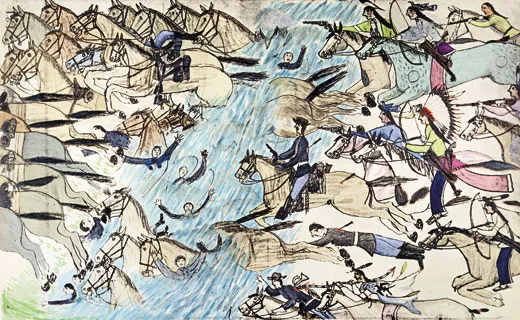
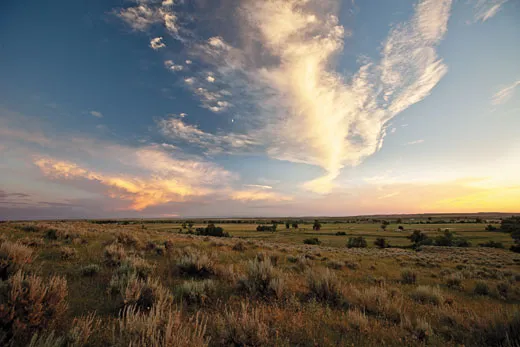
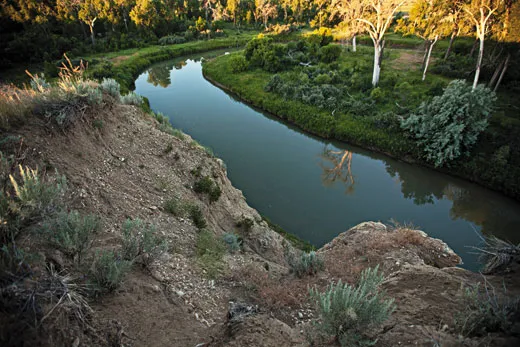
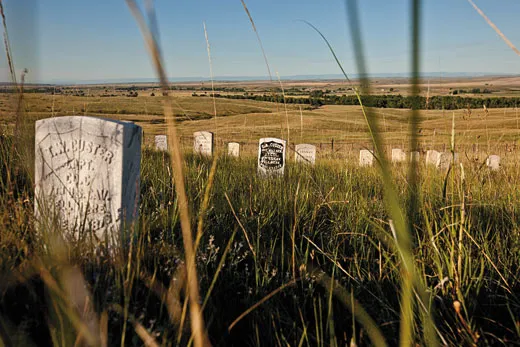
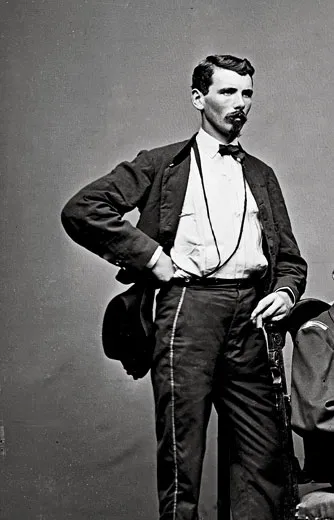
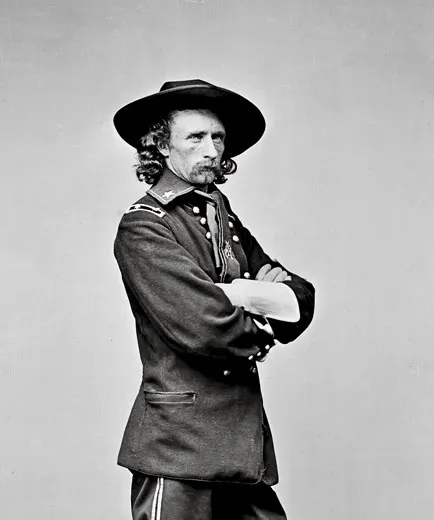
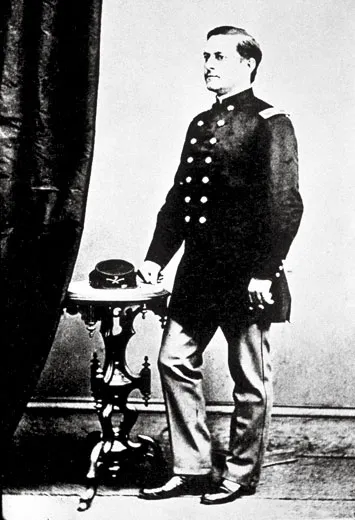
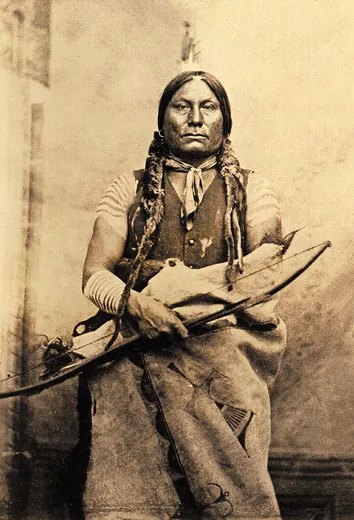
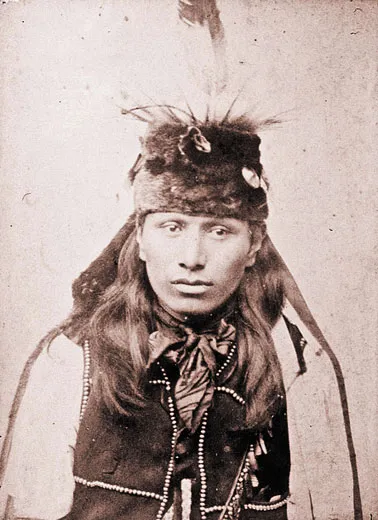
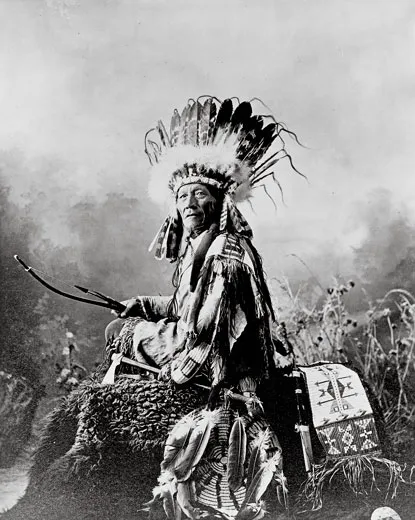
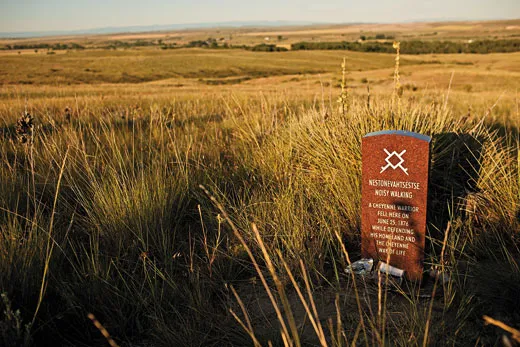
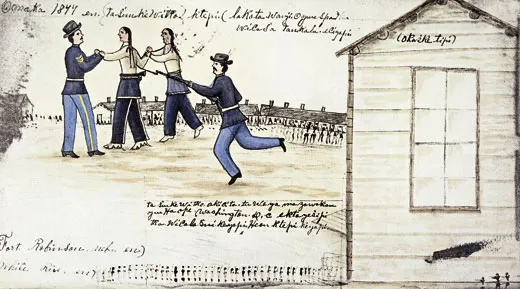
0 Response to "Im Dressed Again to Face a New Day to Keep the Peace and Fight Not to Die"
Post a Comment